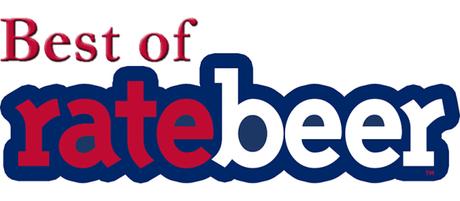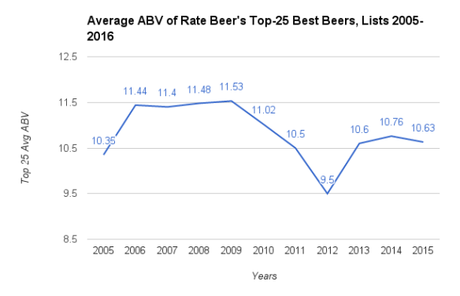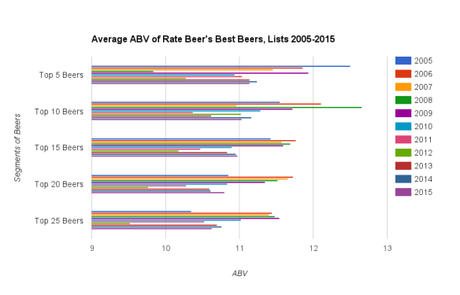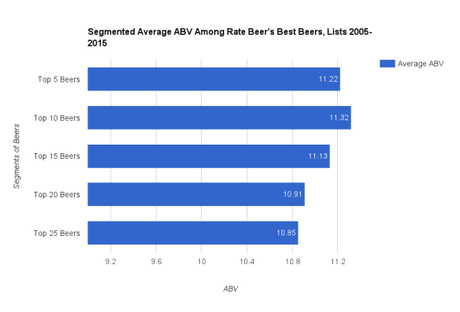
Earlier this month we took a look at 2015's best beers as selected by writers, bloggers and beer enthusiasts.
Today, we step it up to an annual celebration of "best" by one of the Internet's main beer reviewing website, RateBeer. Over the weekend, the site released their annual collection of best beers of the year, according the reviews of users from the last year and weighted by performance within and outside of style.
As in years past, the list of 100 beers offers a great opportunity for analysis, trying to seek out changing tastes, preferences and insight into beer drinkers and our culture.
So grab your abacus and put in your pocket protector, because it's time to crunch some numbers.
Of the 100 beers selected, here's how the selection process broke down among styles:

As we've seen time and time again, higher ABV brands typically rule these kinds of lists. Imperial stouts and double IPAs are always at the top and in the case of RateBeer's 2015 picks, it's much of the same, representing 46 percent of the total.
If you're curious about how 2015's style selections look against 2014, here's the comparison:
In the scheme of things, the loss of seven imperial stouts is a bit bigger of a deal than the number suggests. The distribution of beers across other styles reflects some of today's trends we often talk about, most notably the popularity of sour/wild ales. That drop of "regular" IPAs is significant too, but there is a slight uptick in the imperial version of the style. Why is this happening? It most certainly has to do with the prevalence of these other styles - surely you've noticed that barrel programs and sour beers are popping up fast. So while there is truth that "people want more lower ABV beers," I'd first argue that with 4,100-plus breweries, a diverse collection of brands is necessary, which leads to more options.
Of note are the four pale ales represented by Three Floyds (Zombie Dust), Trillium (Fort Point) and Hill Farmstead (Citra and Nelson Sauvin single hop). Pale ales that drink like IPAs with a touch of rarity thrown in for good measure.
A quick look at the most-cited styles (anything with more than five mentions) doesn't show a direct correlation between ABV and RateBeer's weighted ranking ( explained here):
The average ABV of all 100 best beers is actually down from last year, from 9.95 to 9.55. I would assume this is influenced by the fewer imperial IPAs and the greater representation of styles like sour/wild, lambic and pale ale.
Of the 100 beers picked for 2015's best beers, 37 were different from last year. Some of those lost are pretty iconic and include:
- Dogfish Head 90 Minute
- Great Divide Yeti
- Samuel Adams Utopias
- Stone Enjoy By IPA
You can see a full list of beers that dropped off this year's list here.
The replacements are some of the hotter names that you've certainly come across in recent years, including darlings like:
- Tree House Julius
- Stillwater Gose Gone Wild
- New Glarus Wisconsin Belgian Red
- Firestone Walker Wookey Jack
A full list of the newly added beers is available here.
For an idea of just how tastes have shifted in rating for style diversity, the comparison of styles that were taken off and added on:
To emphasize the point, take a look at the decrease in average ABV between these two categories while the averaged weighted ranking doesn't change much:
I realize that many now talk about the shift of American palates to fewer "extreme" beers, but that's something I don't fully believe. Firstly, it depends on what your definition of "extreme" is, because while the ABV might have gone down - and more than 1 percent feels significant - the lost beers are replaced by brands that still reflect our want for intense flavors, whether a pale ale hopped to the heavens or a sour/wild beer that makes us pucker.
A quick note on the 63 returning beers from 2014's list that reappear in 2015. Of the bunch:
- 34 saw their ratings go up
- 7 had ratings go down
- 22 stayed the same
For the most part, changes in ratings were minimal, especially for those beers that saw their weighted rank decrease. We're talking a hundredth of a point.
But several beers that saw ratings increases had somewhat significant jumps, given the amount of effort and high ratings needed to see the increase. Here are five of the top movers:
I would say there's no surprise the beers represented here are from the most popular style categories of imperial stout, IPA and DIPA.
However, when looking at the lists' best of the best over the last decade, there is most certainly a preference toward higher-ABV brews. I've taken the top-25 beers from previous years to compare, using RateBeer's weighted ranking system.
First, looking at the averaged ABV of the top-quarter of each list, you'll see we've apparently hit a plateau in the upper 10 percent range:

Of note, that dip in 2012 is because of the inclusion of four beers under 8 percent ABV: Cantillon Fou' Foune (5 percent), 3 Fonteinen Framboos (5 percent), Three Floyds Zombie Dust (6.4 percent), and Hill Farmstead Society & Solitude #5 (7.8 percent). Needless to say, this is a rarity among RateBeer lists.
The average ABV of beers among the top twenty-five often show decreases in ABV as averages are compiled and broken down into sub-groups. This chart shows a slight decrease between the mean ABV of beers from the top five, 10, 15, 20, and 25:

Additionally, the average alcohol content of these segmented collections show higher ABV at the top, with a decrease of 0.47 percent ABV in the top-10 beers relative to all 25 ranked beers.

Differences in overall ABV are minimal, but do exist. Most notably, these charts of beers that are considered the "best" of the best, per RateBeer users, are in some cases almost twice as high as the mean craft beer ABV of 5.9 percent, more than two standard deviations from that number.
Take a deep breath because we're not done yet. RateBeer released a collection of best new beers in 2015, so we'll soon take a look at what those numbers offer us, too.
Bryan Roth
"Don't drink to get drunk. Drink to enjoy life." - Jack Kerouac

